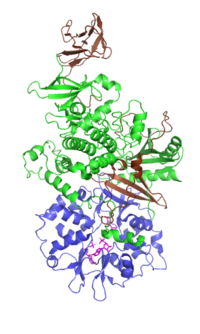
Photo from wikipedia
Endoplasmic reticulum stress (ER stress) contributes to the development of pulmonary fibrosis, especially in type II alveolar epithelial cells (AECs) apoptosis. ER stress also promotes NLRP3 inflammasome activation which is… Click to show full abstract
Endoplasmic reticulum stress (ER stress) contributes to the development of pulmonary fibrosis, especially in type II alveolar epithelial cells (AECs) apoptosis. ER stress also promotes NLRP3 inflammasome activation which is inhibited by upregulation of cAMP/PKA pathway. However, it is confused whether ER stress-induced NLRP3 inflammasome activation and pyroptosis in type II alveolar epithelial cells which exacerbates pulmonary fibrosis via a mechanism that is suppressed by cAMP/PKA pathway. In our research, we explored that potential links among NLRP3 inflammasome, ER stress, and cAMP/PKA pathway in type II AECs to explain the new mechanisms of pulmonary fibrosis. We found that in vivo, ER stress, NLRP3 inflammasome, and PKA upregulated in the alveolar epithelial area in animal models of pulmonary fibrosis. In addition, immunofluorescence staining further confirmed that ER stress, NLRP3 inflammasome, and cAMP/PKA had potential links on type II AECs in BLM group. In vitro, ER stress stimulated NLRP3 inflammasome activation, promoted pyroptosis, and also upregulated cAMP/PKA pathway. Upregulation of cAMP/PKA pathway inhibited ER stress-induced pyroptosis of A549 cells and vice versa. These results initially supported conclusion that ER stress may stimulate NLRP3 inflammasome activation and pyroptosis in type II AECs, which exacerbated pulmonary fibrosis, and cAMP/PKA pathway may act as a feedback regulator.
Journal Title: Journal of Immunology Research
Year Published: 2022
Link to full text (if available)
Share on Social Media: Sign Up to like & get
recommendations!